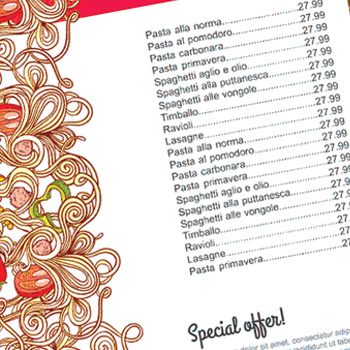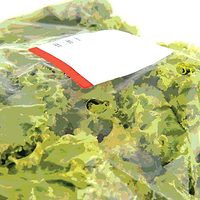It’s easy to remember what life was like before menu labeling. Things were simpler, more efficient and menus were less hectic. Or were they?
Just a few years ago, consumers seemed to care more about what they were buying from grocery stores than restaurants because that’s where a majority of their purchasing decisions were being made. Yet those same grocery dollars are now being spent away from home as the popularity of dining out has grown stronger. This has put a focus on the nutritional content of what restaurants are putting on the menu.
While this appears to be a nuisance for some restaurant operators, for diners with special dietary needs, this is a blessing. For those diners, there have always been hidden dangers lurking on restaurant menus that have historically taken a less-is-more approach. Now that the U.S. Food and Drug Administration (FDA) has approved menu labeling and trans fat mandates, diners have more access to nutritional information.
The new regulations are forcing foodservice operators to respond to customer demand for full transparency on the health implications of the foods they are offering. At the same time, the new rules are setting the expectation that restaurateurs will be knowledgeable about the ingredients and nutrient makeup of their menu items.
While the regulations don’t speak specifically to food allergen labeling, having other nutritional information displayed on the menu will pave the way for patrons to expect this same level of information and candidness for food allergens. Today, it is estimated that 15 million Americans have a food allergy. When this segment of the population goes out to a restaurant, they are already asking questions, and with the new menu-labeling and trans fat regulations, they are going to start expecting answers.
Menu Labeling
Now that the menu-labeling mandate is set to begin December 1, 2016, operators have more time to gather their information and effectively communicate it on paper menus and menu boards. They also will have more time to work with industry organizations and third-party providers to ensure they are accurately following the rules. For example, the National Restaurant Association has long supported a uniform menu-labeling standard and has said it will continue to work with FDA for a smooth transition for both restaurants and consumers.
While the menu-labeling legislation does not specifically address issues of food safety, it should give everyone more insight as to what goes into each menu item. This will enable staff to better answer questions that pertain to specialty-needs diners.
The delay also gives FDA time to figure out some of the finer details of the menu-labeling legislation. For example, questions remain concerning serving size, which organization will be the enforcing body and/or what the penalties will be for noncompliance. Allowing more time will make things much clearer and easier for all concerned.
And if food safety is an issue, this also will give operators time to prepare the correct protocols for handling specialty-needs requests. This can include the development of a color-coded food production method for allergen-free menu items and/or the production of a disclaimer that can be used on paper menus or menu boards.
Operators need to keep in mind that everything they do—and will do in the future—should be about protecting the lives and health of their customers. FDA is not working this hard to make it more difficult for restaurant operators to run their businesses. In fact, it’s quite the opposite, from my view. Everything happening now is about protecting operators from unwarranted criticism or lawsuits because FDA is offering another layer of protection for everyone involved.
For operators to be fully prepared by December 1, 2016, we recommend they take the following steps:
Step 1. Get Your Recipes and Ingredients Together: Gather the recipes and ingredients of your menu items and work with a third party to create the nutritional information for your menu items. If your nutritional information is more than 2 years old—or if you’ve changed suppliers and/or ingredients—have someone double-check the nutritional information of your menu items and verify it for accuracy.
Step 2. Verify Your Information: Once you have gathered your nutritional information, have it verified by a third party. Additionally, if your nutritional information is more than 1 year old—or if you’ve changed suppliers and/or ingredients—reanalyze your nutritional information and verify it for accuracy. If you change just one manufactured product, it could alter the nutritional calculation of all your menu items. Your entire reputation will be based on the accuracy of your nutritional information because people need to trust and believe the information you’re providing is accurate.
Step 3. Identify Allergen-Containing and Gluten-Free Menu Items: Once you produce your nutritional information, identify items with allergens along with what is or isn’t gluten-free. You can do this through a nutritional analysis partner. Once you have identified those menu items, place an asterisk (*) or special image next to the menu item to communicate its designation as an allergen-containing or gluten-free menu item. This will help your team respond to allergen requests and will teach staff how to effectively communicate a guest’s special dietary needs to the kitchen.
Step 4. Communicate Your Nutritional Information in Your Restaurants: Once the nutritional information of your menu items has been gathered and verified, have a plan ready for communicating the information to guests. Use in-store charts to highlight the nutritional calculations of restaurant menu items in addition to posting this information on in-store menus and menu boards.
Step 5. Communicate Your Nutritional Information on the Web: Once you have communicated your nutritional information in your stores, you should provide that same information on your website. To prevent being the target of a patent troll, use a third-party provider to update your online nutritional information.
Step 6. Create a Disclaimer and Policy: Create a policy for both your back-of-house and front-of-house crews. This policy should reflect how each person handles and reacts to questions about allergens and gluten-free menu items. Policies also should include the resources you use in your restaurant to handle special dietary needs and how your staff handles customers with special requests.
Step 7. Maintain Your Information: Be prepared to publicly state who provides your nutritional analysis. Retain a good working relationship with your nutrition analysis provider so your information is always up to date, even when you add new items or change your ingredient supplier.
Trans Fats Mandate
While the push to remove artificial trans fats from menu items is not new, FDA recently acted to eliminate artificial trans fats from the industry. Guests are becoming accustomed to transparency with their food, so it makes sense that the next step for consumers is wanting to know the exact ingredients composing their favorite meals and eliminating the ones getting the most negative attention.
It can be a shock to our clients when they find out that many of the ingredients they use actually contain trans fats. It’s not that they misread the label; rather, trans fats under a certain percent do not have to be singled out on nutritional disclosures.
This is because trans fats, or partially hydrogenated oils (PHOs), do not have to be labeled if they contain less than 0.5 grams of trans fat per serving. This tends to mislead consumers, chefs and members of the foodservice industry because trans fats actually exist in almost everything. According to the Environmental Working Group, 87 percent of products that contain PHOs list 0 grams of trans fat on their labels, which is a startling statistic.
The new federal restriction on artificial trans fat that passed June 6, 2015 is looking to address this issue. The good news is that FDA has given operators 3 years to make the change as a way to allow companies to reformulate their products that use these oils and to allow certain companies to petition FDA to permit certain uses of them.
The federal government is taking such a hard stand on this issue in an effort to reduce the cases of coronary heart disease and prevent the high number of heart attacks that occur each year. There is no health benefit to trans fat in any way. The main purpose of these PHOs is to increase a product’s shelf life and make certain foods easier to cook.
However, consumers are now indicating that they no longer want artificial ingredients in the menu items they choose. This has led restaurant brands from across multiple segments to commit to healthier menu items.
Notable Responses
One of the most popular stories is Chipotle’s declaration[1] that it will no longer be cooking with ingredients that contain genetically modified organisms (GMOs). While there has been some pushback due to Chipotle’s continued use of animals raised on GMO feed and keeping traditional soft drinks in its stores, the overall reaction from Chipotle’s consumer base has been positive. Concerns over the environmental impact of GMOs as well as the desire for more long-term studies of the health impact of GMOs were two of the reasons Chipotle cited for making its decision. While the retail food industry has been dealing with the demand for additional GMO transparency over the past few years, Chipotle was among the first notable restaurants to make this kind of move.
Panera Bread is another large restaurant brand that made headlines with its “No-No List.”[2] The company has pledged to remove all artificial preservatives, sweeteners, colors and flavors from the food in its bakery-cafes by the end of 2016. Meanwhile, Yum! Brands’ Pizza Hut and Taco Bell, along with Papa John’s, Subway and Noodles & Co., have all also opted to remove artificial ingredients from their menus. Each brand has a slightly different take on what “artificial” really means, but it’s clear that they’re answering consumers’ calls when it comes to what they want—and don’t want—in their food.
Foodservice operators can prepare for the trans fat restriction by taking these few necessary steps:
Step 1. Find Out What Ingredients You Use That Have Trans Fat: Review your menu items and look for labels that include the term “partially hydrogenated oils.” Make a list of those products and review the ones that need to be replaced with trans-fat-free alternatives.
Step 2. Start Sourcing Alternate Products: Ask your suppliers where you might find a sufficient substitute product at an attractive price point. Sometimes these alternative products come at a higher price, so look for options that keep your food costs as low as possible without sacrificing quality and taste. Find alternatives such as products that contain soy oil and that work as well as the original yet are easy to replace.
Step 3. Make the Right Statement about Your Menu: There is no greater watchdog than consumers, and they will not hesitate to call out a brand they feel is misleading the public.
Keep in mind that there is also going to be a whole lot of confusion over naturally occurring trans fats as compared with artificial trans fat. We have been dealing with customers who have believed their menu items have been trans-fat-free, only for them to learn that these items do actually have a percentage of PHOs. Part of our job now is to make sure that what our clients communicate to the public and about their menu is as accurate as possible.
Betsy Craig is the CEO and founder of MenuTrinfo, LLC, a nutrition/menu labeling company.
References
1. www.latimes.com/business/la-fi-chipotle-gmo-20150427-story.html.
2. www.panerabread.com/en-us/company/food-policy-no-no-list.html.




